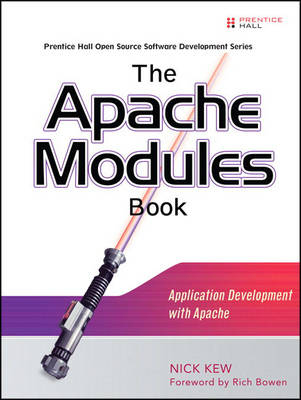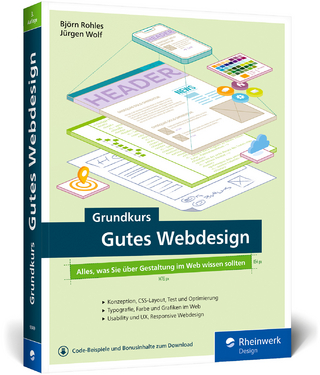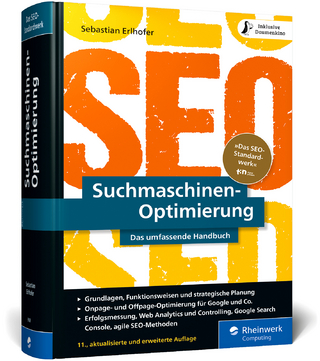
The Apache Modules Book
Prentice Hall (Verlag)
978-0-13-240967-4 (ISBN)
- Titel ist leider vergriffen;
keine Neuauflage - Artikel merken
"Do you learn best by example and experimentation? This book is ideal. Have your favorite editor and compiler ready–you'll encounter example code you'll want to try right away. You've picked the right book–this is sure to become the de facto standard guide to writing Apache modules."
–Rich Bowen, coauthor, Apache Administrators Handbook, Apache Cookbook, and The Definitive Guide to Apache mod_rewrite
"A first-rate guide to getting the most out of Apache as a modular application platform–sure to become a must-read for any Apache programmer, from beginner to experienced professional. It builds up carefully and meticulously from the absolute basics, while including chapters on everything from the popular Apache DBD Framework to best practices, security, and debugging."
–Noirin Plunkett, documentation committer to the Apache httpd project, and member of the ASF conference committee
The Only Comprehensive Guide to Developing Apache 2.x Modules and ApplicationsApache is more than the world's most popular Web server–it's also an extraordinarily powerful and extensible development platform. Now, ApacheTutor.org's Nick Kew has written The Apache Modules Book, the first start-to-finish, example-rich guide for every developer who wants to make the most of Apache.
Kew begins with detailed, accessible introductions to Apache's architecture and API, then illuminates all the techniques you'll need, from request processing through code security. He brings together the best of both worlds: powerful C-based techniques for accomplishing tasks Perl or PHP can't handle, implemented with tools that deliver all the productivity you'd expect from higher-level languages. Utilizing realistic code samples, Kew introduces techniques documented in no other book-and, often, nowhere else at all.
Coverage includes
Using Apache Portable Runtime (APR) to streamline C development and avoid its pitfalls
Leveraging Apache DBD to build applications far more scalable than classic LAMP software
Working with the latest Apache 2.x features: filter modules, XML support, and smart proxies
Mastering best practices, from thread safety to multi-platform development
Utilizing the Apache Authentication Framework
Tracing and debugging problems in both Apache and your custom modules
Foreword
Preface
Acknowledgments
About the Author
Chapter 1 Applications Development with Apache
Chapter 2 The Apache Platform and Architecture
Chapter 3 The Apache Portable Runtime
Chapter 4 Programming Techniques and Caveats
Chapter 5 Writing a Content Generator
Chapter 6 Request Processing Cycle and Metadata Handlers
Chapter 7 AAA: Access, Authentication, and Authorization
Chapter 8 Filter Modules
Chapter 9 Configuration for Modules
Chapter 10 Extending the API
Chapter 11 The Apache Database Framework
Chapter 12 Module Debugging
Appendix A Apache License
Appendix B Contributor License Agreements
Appendix C Hypertext Transfer Protocol: HTTP/1.1
Index
About the Web SiteApacheTutor.org contains code examples from the book, all designed for easy use and integration into existing applications.
Nick Kew is a leading developer of Apache applications, many of which can be found at his company's site, http://apache.webthing.com. He is a member of the Apache Web server core development team and of the Apache Software Foundation. He is active in both user and developer support, and gives tutorials and presentations at relevant conferences such as ApacheCon. He created and maintains http://www.apachetutor.org, and writes on Apache topics for a range of leading online publications.
Foreword xxiPreface xxiiiAcknowledgments xxvii About the Author xxix Chapter 1 Applications Development with Apache 1 1.1 A Brief History of the Apache Web Server 1
1.2 The Apache Software Foundation 3
1.3 The Apache Development Process 6
1.4 Apache and Intellectual Property 12
1.5 Further Reading 16
1.6 Summary 19
Chapter 2 The Apache Platform and Architecture 212.1 Overview 21
2.3 Multi-Processing Modules 26
2.4 Basic Concepts and Structures 29
2.5 Other Key API Components 39
2.6 Apache Configuration Basics 41
2.7 Request Processing in Apache 42
2.8 Summary 51
Chapter 3 The Apache Portable Runtime 53 3.1 APR 54
3.2 APR-UTIL 56
3.3 Basic Conventions 57
3.4 Resource Management: APR Pools 59
3.5 Selected APR Topics 68
3.6 Databases in APR/Apache 79
3.7 Summary 83
Chapter 4 Programming Techniques and Caveats 85 4.1 Apache Coding Conventions 85
4.2 Managing Module Data 88
4.3 Communicating Between Modules 90
4.4 Thread-Safe Programming Issues 92
4.5 Managing Persistent Data 93
4.6 Cross-Platform Programming Issues 99
4.7 Cross-MPM Programming Issues 101
4.8 Secure Programming Issues 106
4.9 External Dependencies and Libraries 114
4.10 Modules Written and Compiled in Other Languages 120
4.11 Summary 122
Chapter 5 Writing a Content Generator 123 5.1 The HelloWorld Module 124
5.2 The Request, the Response, and the Environment 130
5.3 The Default Handler 144
5.4 Summary 148
Chapter 6 Request Processing Cycle and Metadata Handlers 151 6.1 HTTP 152
6.2 Request Processing in Apache 155
6.3 Diverting a Request: The Internal Redirect 161
6.4 Gathering Information: Subrequests 163
6.5 Developing a Module 168
6.6 Summary 174
Chapter 7 AAA: Access, Authentication, and Authorization 177 7.1 Security 177
7.2 An Overview of AAA 180
7.3 AAA in Apache 1.x and 2.0 182
7.4 AAA in Apache 2.1/2.2 182
7.5 AAA Logic 185
7.6 Writing AAA Modules 187
7.7 Implementing a Custom Login Scheme 195
7.8 Summary 199
Chapter 8 Filter Modules 201 8.1 Input and Output Filters 202
8.2 Content, Protocol, and Connection Filters 202
8.3 Anatomy of a Filter 205
8.4 The Filter API and Objects 207
8.5 Filter Objects 208
8.6 Filter I/O 210
8.7 Smart Filtering in Apache 2.2 211
8.8 Example: Filtering Text by Direct Manipulation of Buckets 217
8.9 Complex Parsing 221
8.10 Filtering Through an Existing Parser 225
8.11 stdio-Like Filter I/O 227
8.12 Input Filters and the Pull API 230
8.13 Summary 235
Chapter 9 Configuration for Modules 237 9.1 Configuration Basics 237
9.2 Configuration Data Structs 239
9.3 Managing a Module Configuration 239
9.4 Implementing Configuration Directives 242
9.5 The Configuration Hierarchy 250
9.6 Context in Configuration Functions 255
9.7 Custom Configuration Containers 257
9.8 Alternative Configuration Methods 261
9.9 Summary 262
Chapter 10 Extending the API 263 10.1 Implementing New Functions in Apache 264
10.2 Hooks and Optional Hooks 267
10.3 The Provider API 272
10.4 Providing a Service 277
10.5 Cross-Platform API Builds 284
10.6 Summary 288
Chapter 11 The Apache Database Framework 289 11.1 The Need for a New Framework 290
11.2 The DBD Architecture 292
11.3 The apr_dbd API 292
11.4 The ap_dbd API 302
11.5 An Example Application Module: mod_authn_dbd 303
11.6 Developing a New DBD Driver 306
11.7 Summary 320
Chapter 12 Module Debugging 323 12.1 Logging for Debugging 324
12.2 Running Apache Under a Debugger 327
12.3 Special-Purpose Hooks and Modules 333
12.4 Filter Debugging 338
12.5 Summary 341
Appendix A Apache License 343 Appendix B Contributor License Agreements 349 Appendix C Hypertext Transfer Protocol: HTTP/1.1 357 Index 531
| Erscheint lt. Verlag | 5.2.2007 |
|---|---|
| Reihe/Serie | Prentice Hall Open Source Software Development Series |
| Verlagsort | Upper Saddle River |
| Sprache | englisch |
| Maße | 176 x 234 mm |
| Gewicht | 812 g |
| Themenwelt | Mathematik / Informatik ► Informatik ► Netzwerke |
| Mathematik / Informatik ► Informatik ► Programmiersprachen / -werkzeuge | |
| Informatik ► Web / Internet ► Web Design / Usability | |
| Naturwissenschaften ► Physik / Astronomie | |
| ISBN-10 | 0-13-240967-4 / 0132409674 |
| ISBN-13 | 978-0-13-240967-4 / 9780132409674 |
| Zustand | Neuware |
| Haben Sie eine Frage zum Produkt? |
aus dem Bereich


